oil type VOLVO S60 2009 Owner´s Manual
[x] Cancel search | Manufacturer: VOLVO, Model Year: 2009, Model line: S60, Model: VOLVO S60 2009Pages: 254, PDF Size: 6.17 MB
Page 86 of 254

03 ClimateClimate control systems - general information
0386
Condensation on the inside of the
windowsThe defroster function should be used to
remove fog or mist from the inside of the win-
dows. Keeping the windows clean with a com-
mercially available window washing spray will
also help prevent fogging or misting.Ice and snowAlways keep the air intake grille at the base of
the windshield free of snow.Cabin air filterReplace the cabin air filter with a new one at
the recommended intervals. Please refer to
your Warranty and Service Records Informa-
tion booklet, or consult a trained and qualified
Volvo service technician for these intervals.
The filter should be replaced more often when
driving under dirty and dusty conditions. The
filter cannot be cleaned and therefore should
always be replaced with a new one.
SensorsThe sunlight sensor on the dashboard and pas-
senger compartment temperature sensor in
the ECC control panel should not be covered
in any way as this could cause incorrect infor-
mation to be sent to the ECC system.Parking the vehicle in warm weatherIf your vehicle has been parked in the sun in
warm weather, opening the windows and
moonroof (option) for several minutes before
driving will help release the warm air from the
passenger compartment. When the engine is
running, close the windows and moonroof and
use the recirculation function for several
minutes to enable the air conditioning to cool
the compartment as quickly as possible.Windows and optional moonroofThe ECC system will function best if the win-
dows and optional moonroof are closed. If you
drive with the moonroof open, we recommend
that you manually adjust the temperature and
blower control (the LED in the AUTO switch
should be off).
AccelerationThe air conditioning is momentarily disen-
gaged during full-throttle acceleration.Climate control maintenanceSpecial tools and equipment are required to
maintain and carry out repairs on the climate
system. Work of this type should only be done
by a trained and qualified Volvo service tech-
nician.RefrigerantVolvo cares about the environment. The air
conditioning system in your vehicle contains a
CFC-free refrigerant - R134a (HFC134a). This
substance will not deplete the ozone layer. The
system contains 1.5 lbs (700 g) R134a and
uses PAG oil.Climate system blowerThe climate system blower will be automati-
cally switched off when the engine is not run-
ning (even if the ignition key is in position Ior
II) to avoid unnecessary battery drain. To acti-
vate the blower, turn the control to the desired
setting.
Page 148 of 254
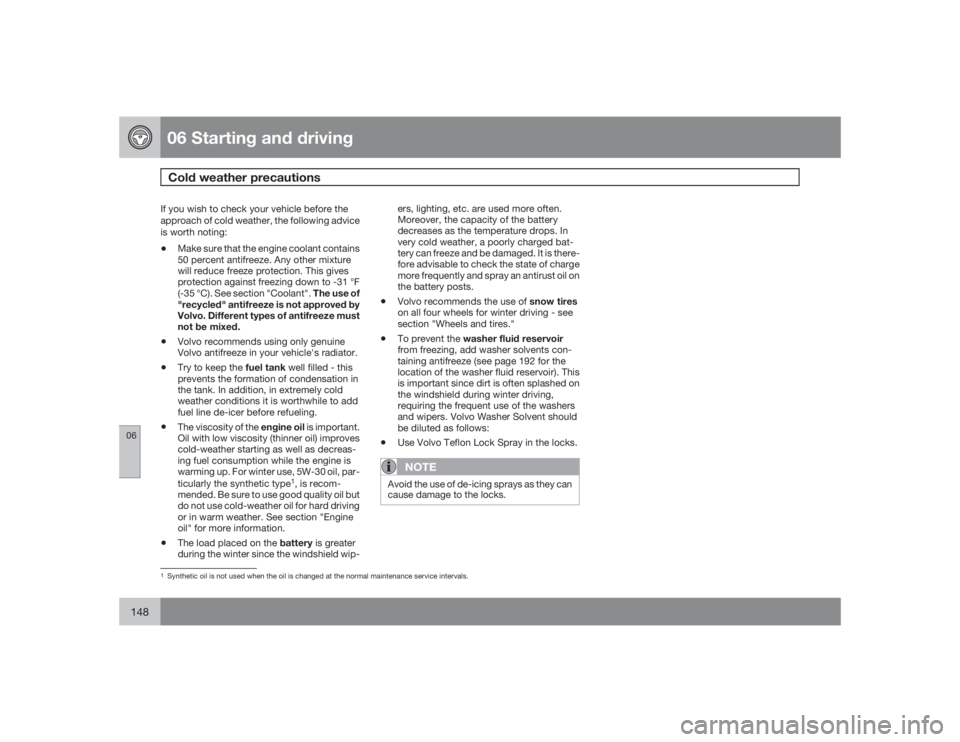
06 Starting and drivingCold weather precautions
06148
If you wish to check your vehicle before the
approach of cold weather, the following advice
is worth noting:•
Make sure that the engine coolant contains
50 percent antifreeze. Any other mixture
will reduce freeze protection. This gives
protection against freezing down to -31 °F
(-35 °C). See section "Coolant". The use of
"recycled" antifreeze is not approved by
Volvo. Different types of antifreeze must
not be mixed.
•
Volvo recommends using only genuine
Volvo antifreeze in your vehicle's radiator.
•
Try to keep the fuel tank well filled - this
prevents the formation of condensation in
the tank. In addition, in extremely cold
weather conditions it is worthwhile to add
fuel line de-icer before refueling.
•
The viscosity of the engine oil is important.
Oil with low viscosity (thinner oil) improves
cold-weather starting as well as decreas-
ing fuel consumption while the engine is
warming up. For winter use, 5W-30 oil, par-
ticularly the synthetic type
1, is recom-
mended. Be sure to use good quality oil but
do not use cold-weather oil for hard driving
or in warm weather. See section "Engine
oil" for more information.
•
The load placed on the battery is greater
during the winter since the windshield wip-ers, lighting, etc. are used more often.
Moreover, the capacity of the battery
decreases as the temperature drops. In
very cold weather, a poorly charged bat-
tery can freeze and be damaged. It is there-
fore advisable to check the state of charge
more frequently and spray an antirust oil on
the battery posts.
•
Volvo recommends the use of snow tires
on all four wheels for winter driving - see
section "Wheels and tires."
•
To prevent the washer fluid reservoir
from freezing, add washer solvents con-
taining antifreeze (see page 192 for the
location of the washer fluid reservoir). This
is important since dirt is often splashed on
the windshield during winter driving,
requiring the frequent use of the washers
and wipers. Volvo Washer Solvent should
be diluted as follows:
•
Use Volvo Teflon Lock Spray in the locks.NOTE
Avoid the use of de-icing sprays as they can
cause damage to the locks.
1Synthetic oil is not used when the oil is changed at the normal maintenance service intervals.
Page 154 of 254
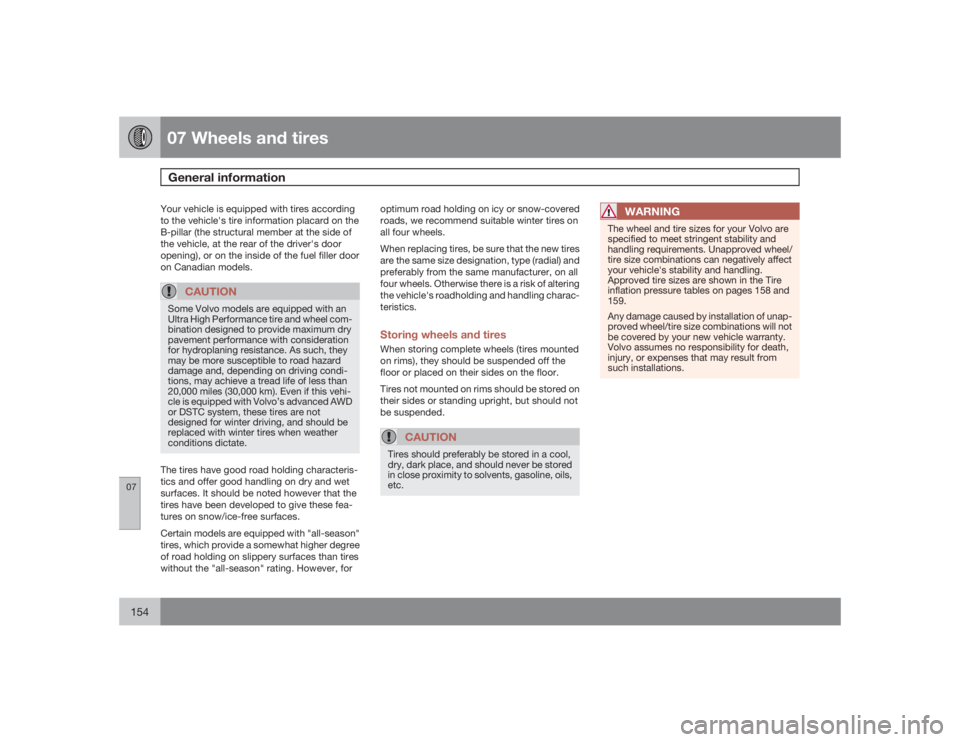
07 Wheels and tiresGeneral information
07154
Your vehicle is equipped with tires according
to the vehicle's tire information placard on the
B-pillar (the structural member at the side of
the vehicle, at the rear of the driver's door
opening), or on the inside of the fuel filler door
on Canadian models.
CAUTION
Some Volvo models are equipped with an
Ultra High Performance tire and wheel com-
bination designed to provide maximum dry
pavement performance with consideration
for hydroplaning resistance. As such, they
may be more susceptible to road hazard
damage and, depending on driving condi-
tions, may achieve a tread life of less than
20,000 miles (30,000 km). Even if this vehi-
cle is equipped with Volvo’s advanced AWD
or DSTC system, these tires are not
designed for winter driving, and should be
replaced with winter tires when weather
conditions dictate.The tires have good road holding characteris-
tics and offer good handling on dry and wet
surfaces. It should be noted however that the
tires have been developed to give these fea-
tures on snow/ice-free surfaces.
Certain models are equipped with "all-season"
tires, which provide a somewhat higher degree
of road holding on slippery surfaces than tires
without the "all-season" rating. However, foroptimum road holding on icy or snow-covered
roads, we recommend suitable winter tires on
all four wheels.
When replacing tires, be sure that the new tires
are the same size designation, type (radial) and
preferably from the same manufacturer, on all
four wheels. Otherwise there is a risk of altering
the vehicle's roadholding and handling charac-
teristics.
Storing wheels and tiresWhen storing complete wheels (tires mounted
on rims), they should be suspended off the
floor or placed on their sides on the floor.
Tires not mounted on rims should be stored on
their sides or standing upright, but should not
be suspended.
CAUTION
Tires should preferably be stored in a cool,
dry, dark place, and should never be stored
in close proximity to solvents, gasoline, oils,
etc.
WARNING
The wheel and tire sizes for your Volvo are
specified to meet stringent stability and
handling requirements. Unapproved wheel/
tire size combinations can negatively affect
your vehicle's stability and handling.
Approved tire sizes are shown in the Tire
inflation pressure tables on pages 158 and
159.
Any damage caused by installation of unap-
proved wheel/tire size combinations will not
be covered by your new vehicle warranty.
Volvo assumes no responsibility for death,
injury, or expenses that may result from
such installations.
Page 188 of 254
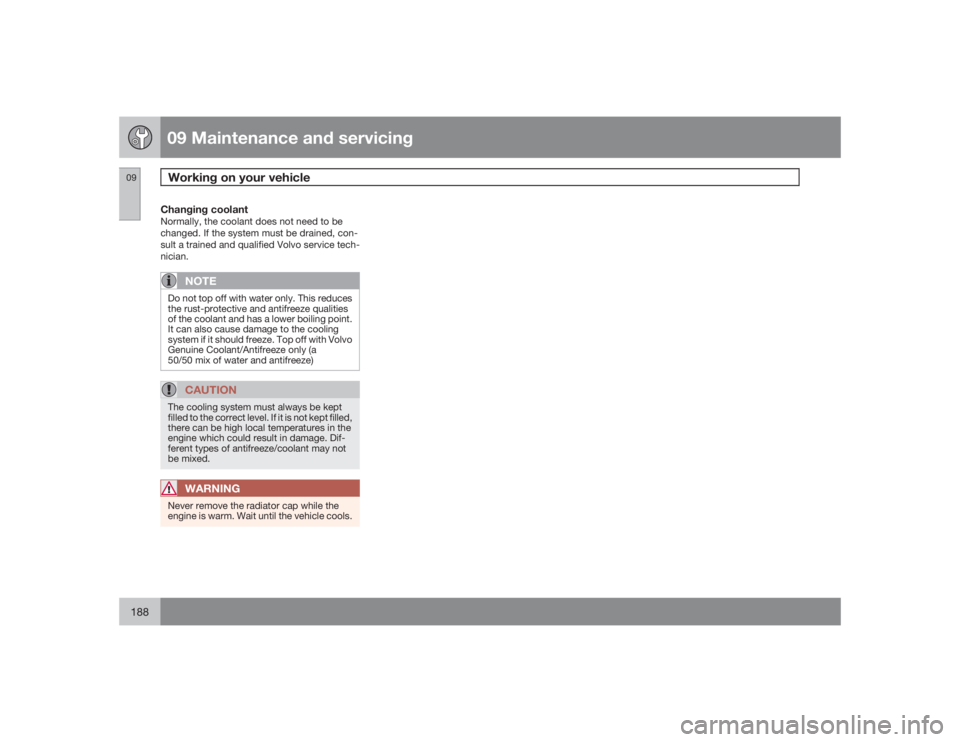
09 Maintenance and servicingWorking on your vehicle
09188
Changing coolantNormally, the coolant does not need to be
changed. If the system must be drained, con-
sult a trained and qualified Volvo service tech-
nician.
NOTE
Do not top off with water only. This reduces
the rust-protective and antifreeze qualities
of the coolant and has a lower boiling point.
It can also cause damage to the cooling
system if it should freeze. Top off with Volvo
Genuine Coolant/Antifreeze only (a
50/50 mix of water and antifreeze)
CAUTION
The cooling system must always be kept
filled to the correct level. If it is not kept filled,
there can be high local temperatures in the
engine which could result in damage. Dif-
ferent types of antifreeze/coolant may not
be mixed.
WARNING
Never remove the radiator cap while the
engine is warm. Wait until the vehicle cools.
Page 191 of 254
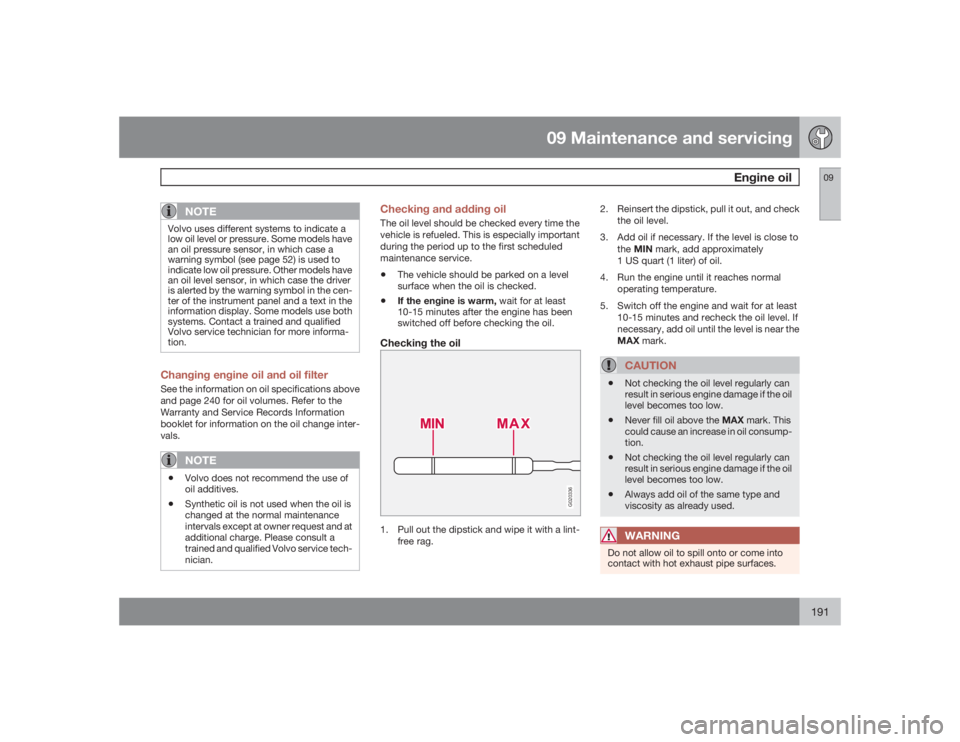
09 Maintenance and servicing
Engine oil
09
191
NOTE
Volvo uses different systems to indicate a
low oil level or pressure. Some models have
an oil pressure sensor, in which case a
warning symbol (see page 52) is used to
indicate low oil pressure. Other models have
an oil level sensor, in which case the driver
is alerted by the warning symbol in the cen-
ter of the instrument panel and a text in the
information display. Some models use both
systems. Contact a trained and qualified
Volvo service technician for more informa-
tion.Changing engine oil and oil filterSee the information on oil specifications above
and page 240 for oil volumes. Refer to the
Warranty and Service Records Information
booklet for information on the oil change inter-
vals.
NOTE
•
Volvo does not recommend the use of
oil additives.
•
Synthetic oil is not used when the oil is
changed at the normal maintenance
intervals except at owner request and at
additional charge. Please consult a
trained and qualified Volvo service tech-
nician.
Checking and adding oilThe oil level should be checked every time the
vehicle is refueled. This is especially important
during the period up to the first scheduled
maintenance service.•
The vehicle should be parked on a level
surface when the oil is checked.
•
If the engine is warm, wait for at least
10-15 minutes after the engine has been
switched off before checking the oil.
Checking the oil
G020336
1. Pull out the dipstick and wipe it with a lint-
free rag.2. Reinsert the dipstick, pull it out, and check
the oil level.
3. Add oil if necessary. If the level is close to
theMINmark, add approximately
1 US quart (1 liter) of oil.
4. Run the engine until it reaches normal
operating temperature.
5. Switch off the engine and wait for at least
10-15 minutes and recheck the oil level. If
necessary, add oil until the level is near the
MAX mark.
CAUTION
•
Not checking the oil level regularly can
result in serious engine damage if the oil
level becomes too low.
•
Never fill oil above the MAX mark. This
could cause an increase in oil consump-
tion.
•
Not checking the oil level regularly can
result in serious engine damage if the oil
level becomes too low.
•
Always add oil of the same type and
viscosity as already used.WARNING
Do not allow oil to spill onto or come into
contact with hot exhaust pipe surfaces.
Page 192 of 254
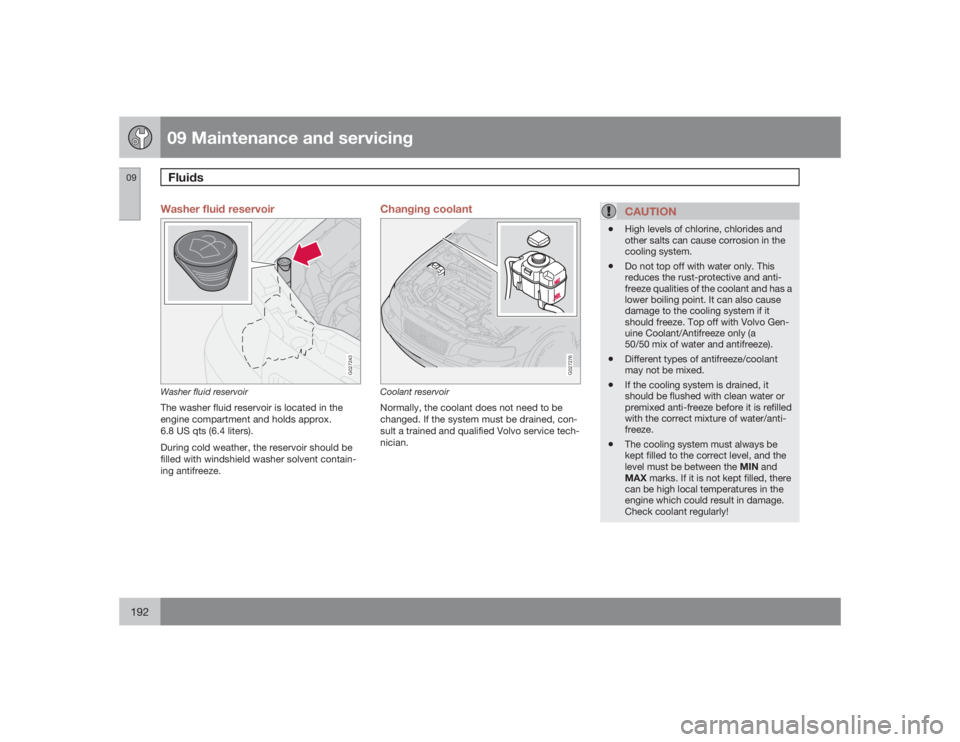
09 Maintenance and servicingFluids
09192
Washer fluid reservoir
G027243
Washer fluid reservoirThe washer fluid reservoir is located in the
engine compartment and holds approx.
6.8 US qts (6.4 liters).
During cold weather, the reservoir should be
filled with windshield washer solvent contain-
ing antifreeze.
Changing coolant
G027276
Coolant reservoirNormally, the coolant does not need to be
changed. If the system must be drained, con-
sult a trained and qualified Volvo service tech-
nician.
CAUTION
•
High levels of chlorine, chlorides and
other salts can cause corrosion in the
cooling system.
•
Do not top off with water only. This
reduces the rust-protective and anti-
freeze qualities of the coolant and has a
lower boiling point. It can also cause
damage to the cooling system if it
should freeze. Top off with Volvo Gen-
uine Coolant/Antifreeze only (a
50/50 mix of water and antifreeze).
•
Different types of antifreeze/coolant
may not be mixed.
•
If the cooling system is drained, it
should be flushed with clean water or
premixed anti-freeze before it is refilled
with the correct mixture of water/anti-
freeze.
•
The cooling system must always be
kept filled to the correct level, and the
level must be between the MIN and
MAX marks. If it is not kept filled, there
can be high local temperatures in the
engine which could result in damage.
Check coolant regularly!
Page 193 of 254
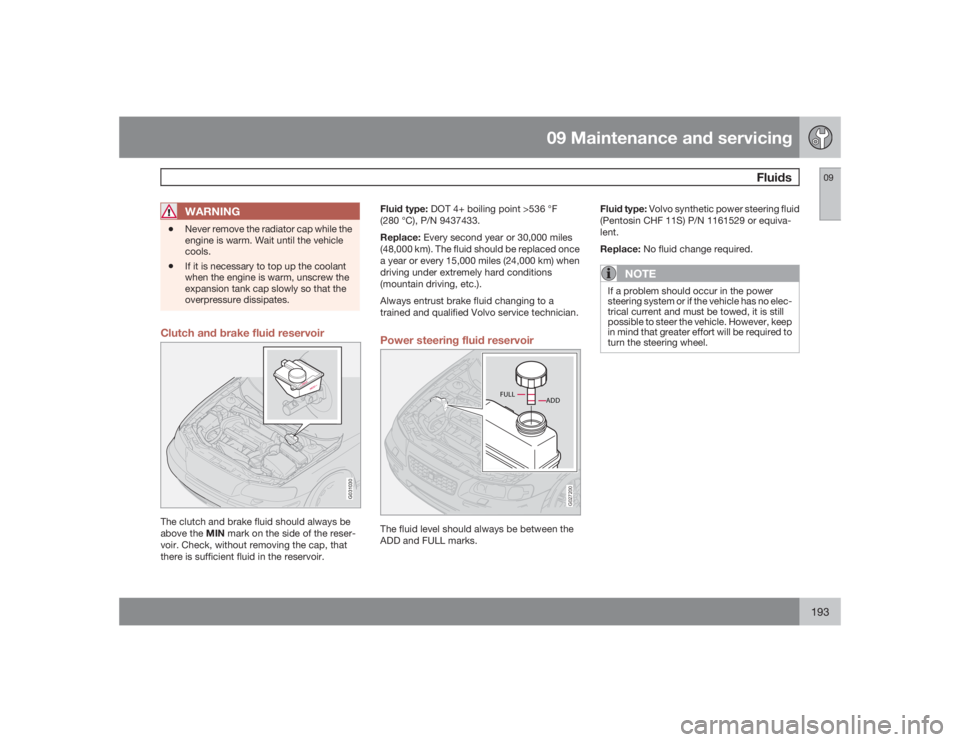
09 Maintenance and servicing
Fluids
09
193
WARNING
•
Never remove the radiator cap while the
engine is warm. Wait until the vehicle
cools.
•
If it is necessary to top up the coolant
when the engine is warm, unscrew the
expansion tank cap slowly so that the
overpressure dissipates.
Clutch and brake fluid reservoir
G031030
The clutch and brake fluid should always be
above the MIN mark on the side of the reser-
voir. Check, without removing the cap, that
there is sufficient fluid in the reservoir.Fluid type: DOT 4+ boiling point >536 °F
(280 °C), P/N 9437433.
Replace: Every second year or 30,000 miles
(48,000 km). The fluid should be replaced once
a year or every 15,000 miles (24,000 km) when
driving under extremely hard conditions
(mountain driving, etc.).
Always entrust brake fluid changing to a
trained and qualified Volvo service technician.
Power steering fluid reservoir
ADD FULL
G027200
The fluid level should always be between the
ADD and FULL marks.Fluid type: Volvo synthetic power steering fluid
(Pentosin CHF 11S) P/N 1161529 or equiva-
lent.
Replace: No fluid change required.
NOTE
If a problem should occur in the power
steering system or if the vehicle has no elec-
trical current and must be towed, it is still
possible to steer the vehicle. However, keep
in mind that greater effort will be required to
turn the steering wheel.
Page 234 of 254
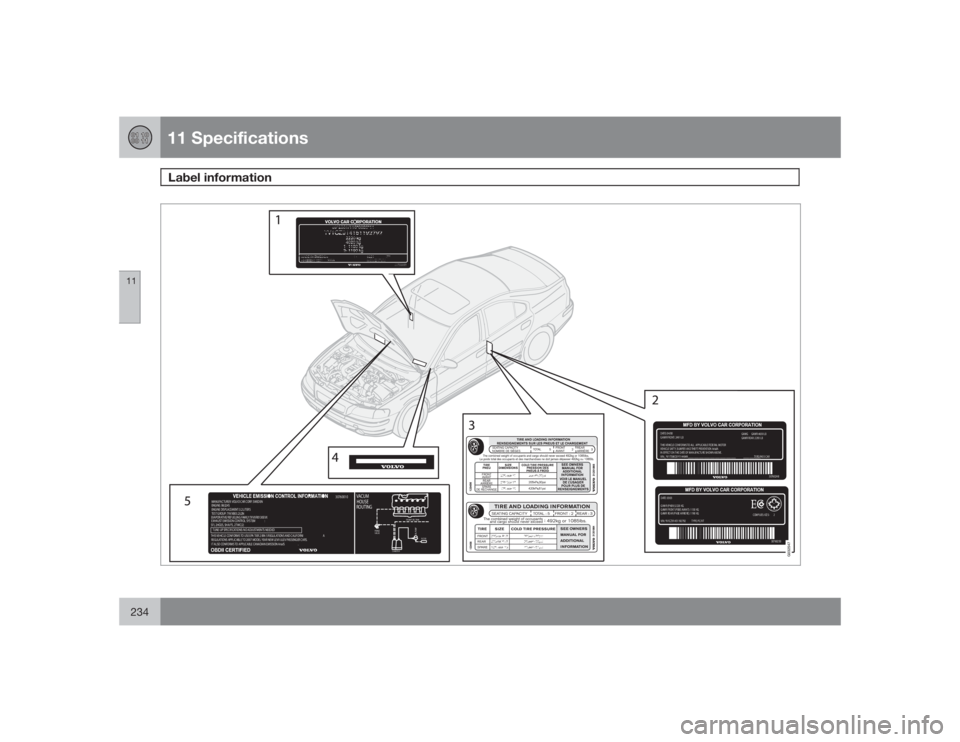
11 SpecificationsLabel information
11234
REGULATIONS APPLICABLE TO 2007 MODEL YEAR NEW LEVII ULEV PASSENGER CARS. THIS VEHICLE CONFORMS TO USE EPA TIER 2 BIN 5 REGULATIONS AND CALIFORNI A
IT ALSO CONFORMS TO APPLICABLE CANADIAN EMISSION ArialS . EVAPORATIVE/REFUELING FAMILY:7VVXR0130EVX
TUNE-UP SPECIFICATIONS: NO ADJUSTMENTS NEEDED ENGINE DISPLACEMENT:3.2 LITERSENGINE: B6324S
EXHAUST EMISSION CONTROL SYSTEM :
SFI, 2HO2S, SHA/FS, 2TWC(2)TEST GROUP: 7VVXB03.2U2N MANUFACTURER: VOLVO CAR CORP. SWEDEN
VA LV E PURGE
30760010
CANISTER
OIL PUMPFILTER FROM FUEL TANK
DATE: 0303
GVWR (PNBV ):2220 KG
GAWR FRONT (PBBE AVANT ): 1130 KG
VIN: YV1CZ91451192792 TYPE: PC/VT GAWR REAR (PNBE ARRIERE): 1190 KG
30760250
COMPLIES: ICES- 2
THIS VEHICLE CONFORMS TO ALL APPLICABLE FEDERAL MO TOR
VEHICLE SAFTY, BUMPER AND THEFT PREVENTION ArialA
VIN:_YV1TS90D3Y1144849_______________________________________ ______________TYPE:PASS CAR IN EFFECT ON THE DATE OF MANUFACTURE SHOWN ABOVE.GAWR FRONT: 2491 LB DATE: 04/00
30760248 GAWR REAR: 2293 LBGAWR:4630 LB GAWG
HOUSE VACUM
ROUTING
CCTSPROTNARMVSSDAASNVACNA98 4
G032547
Page 240 of 254
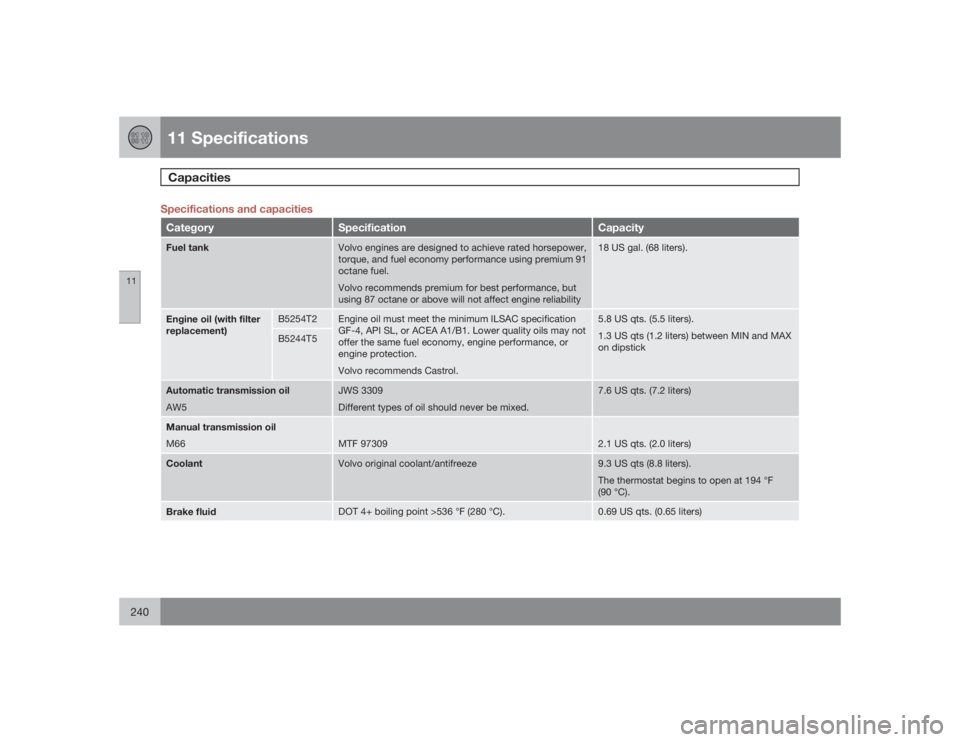
11 SpecificationsCapacities
11240
Specifications and capacitiesCategory
Specification
Capacity
Fuel tank
Volvo engines are designed to achieve rated horsepower,
torque, and fuel economy performance using premium 91
octane fuel.
Volvo recommends premium for best performance, but
using 87 octane or above will not affect engine reliability
18 US gal. (68 liters).
Engine oil (with filter
replacement)
B5254T2
Engine oil must meet the minimum ILSAC specification
GF-4, API SL, or ACEA A1/B1. Lower quality oils may not
offer the same fuel economy, engine performance, or
engine protection.
Volvo recommends Castrol.
5.8 US qts. (5.5 liters).
1.3 US qts (1.2 liters) between MIN and MAX
on dipstick
B5244T5
Automatic transmission oil
AW5
JWS 3309
Different types of oil should never be mixed.
7.6 US qts. (7.2 liters)
Manual transmission oil
M66
MTF 97309
2.1 US qts. (2.0 liters)
Coolant
Volvo original coolant/antifreeze
9.3 US qts (8.8 liters).
The thermostat begins to open at 194 °F
(90 °C).
Brake fluid
DOT 4+ boiling point >536 °F (280 °C).
0.69 US qts. (0.65 liters)